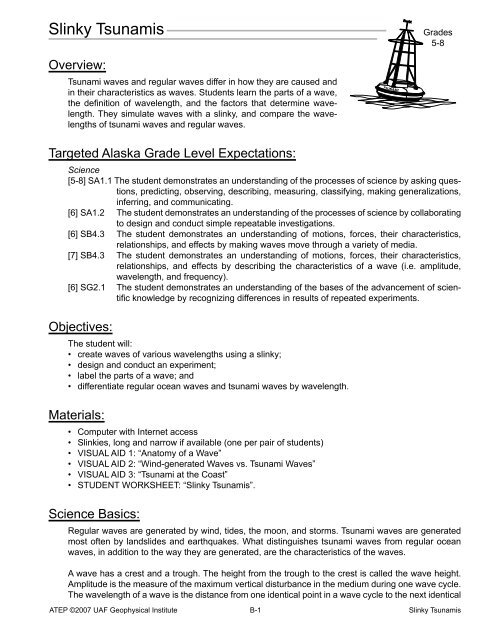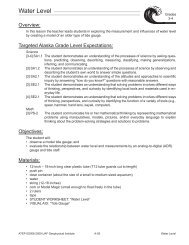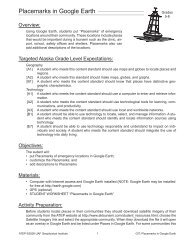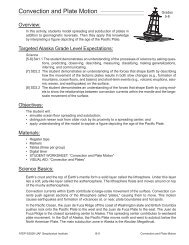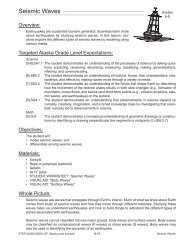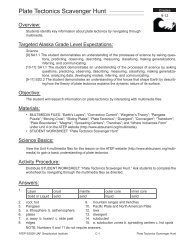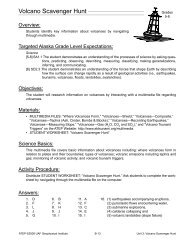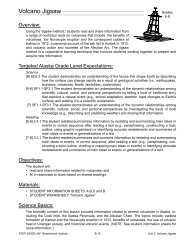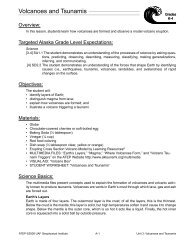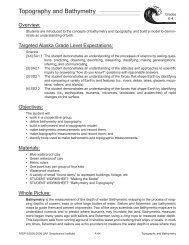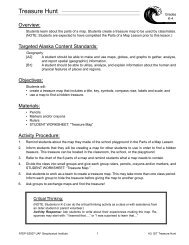Slinky Tsunamis
Slinky Tsunamis
Slinky Tsunamis
You also want an ePaper? Increase the reach of your titles
YUMPU automatically turns print PDFs into web optimized ePapers that Google loves.
<strong>Slinky</strong> <strong>Tsunamis</strong><br />
Grades<br />
5-8<br />
Overview:<br />
Tsunami waves and regular waves differ in how they are caused and<br />
in their characteristics as waves. Students learn the parts of a wave,<br />
the definition of wavelength, and the factors that determine wavelength.<br />
They simulate waves with a slinky, and compare the wavelengths<br />
of tsunami waves and regular waves.<br />
TSUNAMI<br />
Targeted Alaska Grade Level Expectations:<br />
Science<br />
[5-8] SA1.1 The student demonstrates an understanding of the processes of science by asking questions,<br />
predicting, observing, describing, measuring, classifying, making generalizations,<br />
inferring, and communicating.<br />
[6] SA1.2 The student demonstrates an understanding of the processes of science by collaborating<br />
to design and conduct simple repeatable investigations.<br />
[6] SB4.3 The student demonstrates an understanding of motions, forces, their characteristics,<br />
relationships, and effects by making waves move through a variety of media.<br />
[7] SB4.3 The student demonstrates an understanding of motions, forces, their characteristics,<br />
relationships, and effects by describing the characteristics of a wave (i.e. amplitude,<br />
wavelength, and frequency).<br />
[6] SG2.1 The student demonstrates an understanding of the bases of the advancement of scientific<br />
knowledge by recognizing differences in results of repeated experiments.<br />
Objectives:<br />
The student will:<br />
• create waves of various wavelengths using a slinky;<br />
• design and conduct an experiment;<br />
• label the parts of a wave; and<br />
• differentiate regular ocean waves and tsunami waves by wavelength.<br />
Materials:<br />
• Computer with Internet access<br />
• Slinkies, long and narrow if available (one per pair of students)<br />
• VISUAL AID 1: “Anatomy of a Wave”<br />
• VISUAL AID 2: “Wind-generated Waves vs. Tsunami Waves”<br />
• VISUAL AID 3: “Tsunami at the Coast”<br />
• STUDENT WORKSHEET: “<strong>Slinky</strong> <strong>Tsunamis</strong>”.<br />
Science Basics:<br />
Regular waves are generated by wind, tides, the moon, and storms. Tsunami waves are generated<br />
most often by landslides and earthquakes. What distinguishes tsunami waves from regular ocean<br />
waves, in addition to the way they are generated, are the characteristics of the waves.<br />
A wave has a crest and a trough. The height from the trough to the crest is called the wave height.<br />
Amplitude is the measure of the maximum vertical disturbance in the medium during one wave cycle.<br />
The wavelength of a wave is the distance from one identical point in a wave cycle to the next identical<br />
ATEP ©2007 UAF Geophysical Institute B-1 <strong>Slinky</strong> <strong>Tsunamis</strong>
point, most commonly viewed as crest to crest or trough to trough. Tsunami waves have a longer<br />
wavelength than regular waves. In fact, the crests of two neighboring tsunami waves can be as far as<br />
300 miles apart.<br />
Wave Characteristics<br />
wavelength<br />
wave<br />
amplitude<br />
wave<br />
height<br />
crest<br />
trough<br />
Tsunami waves also have a greater period than wind-driven waves. The period of a wave is the time<br />
it takes for the wave to complete one cycle, or the time between wave crests. In the ocean, the period<br />
of a wave indicates how fast the wave is traveling. A regular wind-driven ocean wave has a period of<br />
up to several seconds. The period of a tsunami wave can be ten minutes to two hours.<br />
The extreme height of tsunami waves, sometimes demonstrated as they hit the shore, is a result of<br />
the trough of the wave hitting the shoreline. When this occurs, the speed of the wave is decreased.<br />
However, the energy of the wave is not decreased. As a result, the height of the wave increases and<br />
the wavelength decreases: the steeper the shoreline, the more dramatic the wave height.<br />
Activity Procedure:<br />
1. Review how regular waves are generated by the moon, tides, winds, and storms. Ask students to<br />
recall how tsunami waves can be generated.<br />
2. As a class, brainstorm the characteristics of a tsunami wave. Introduce wavelength and period into the<br />
discussion.<br />
3. Explain that understanding the difference between wind-generated waves and tsunami waves requires<br />
a knowledge of the parts of a wave.<br />
4. Show VISUAL AID 1: “Anatomy of a Wave.” Explain that a wave moves up and down. The top of a wave<br />
is called a crest. The bottom of a wave is called a trough. The wavelength is the distance from crest to<br />
crest or from trough to trough. The height of a wave is the distance from the crest to the trough.<br />
5. Explain that tsunami waves have a much greater wavelength than regular wind-generated ocean<br />
waves. Show VISUAL AID 2: “Wind-generated Waves vs. Tsunami Waves.” Point out the specific<br />
wavelength of each type of wave.<br />
6. Explain that tsunami waves also have a much greater period than regular wind-generated ocean<br />
waves. The period of a wave is the time between wave crests, or the time it takes for the wave to<br />
travel one wavelength. Wind-generated ocean waves have a period of several seconds. Tsunami<br />
waves can have periods of ten minutes to two hours.<br />
7. Discuss how scientists can use this information to determine when a tsunami might hit. (Knowing the<br />
period of a wave allows one to calculate how long it will take the wave to reach a certain point.)<br />
8. As a class or in small groups, use a computer with Internet access to navigate to the National Geographic<br />
Wave Simulator at http://www.nationalgeographic.com/volvooceanrace/interactives/waves/index.html.<br />
Use the sliders on the simulator to change the wave height, wavelength, and wave period in various<br />
ways. How do the changes affect the boat? Discuss as a class. Point out that waves move through<br />
material, they do not move the material itself. Ask students to click on the Water Particles link in the<br />
ATEP ©2007 UAF Geophysical Institute B-2 <strong>Slinky</strong> <strong>Tsunamis</strong>
Wave Simulator and observe the movement of the water particles under the ship.<br />
9. Recruit a volunteer and demonstrate how to make a wave with a slinky. Let the slinky become still<br />
again before trying another method. Explain that one person in each pair should hold the slinky still,<br />
while the other does something to cause the slinky to move. The goal is to create a wave with a very<br />
long wavelength and a wave with a very short wavelength. Explain that a wave with a very long wavelength<br />
may only appear as one wave along the length of the slinky; whereas a wave with a short<br />
wavelength will appear as many waves along the length of the slinky.<br />
10. Divide the class into pairs. Hand out STUDENT WORKSHEET: “<strong>Slinky</strong> <strong>Tsunamis</strong>.”<br />
11. Provide each pair of students with a slinky. Students take turns being the one to move the slinky.<br />
12. Invite each pair of students to come up with one method that creates a wave with a long wavelength<br />
and one method that creates a wave with a short wavelength. Instruct students to note how the amplitude<br />
of the wave changes with each new approach. Ask students to complete their worksheets up<br />
to, but not including, the Further Questions section. The remainder of the worksheet will be completed<br />
after a class discussion.<br />
13. Provide the class with approximately 30 minutes for this exercise.<br />
14. After students have completed the experiment and the assigned portion of their worksheets, invite<br />
them to share their results with the class. Discuss the purpose of repeated trials, and the documentation<br />
of the procedure. (Trials are repeated to further validate results or attempt a different result.<br />
Documentation is important so that the experiment can be repeated precisely and can be communicated<br />
with others.)<br />
Critical Thinking:<br />
Puzzle Method: Develop students’ critical thinking by providing clues to a puzzle<br />
involving aspects of the day’s topic. Ask them to find the solution without providing<br />
input. Explain that as a tsunami wave reaches the coast, the wave often slows down,<br />
increases in height, and decreases in wavelength. Ask students to discuss, in pairs,<br />
why this might occur. Provide 3-5 minutes for this exercise. Invite students to share<br />
their solutions with the class.<br />
Show VISUAL AID 2: “Tsunami at the Coast.” Reveal that as a tsunami wave approaches<br />
the coast, the trough of the wave hits the beach floor causing the wave to<br />
slow down, increase in height, and decrease in wavelength. Explain that the steeper<br />
the shoreline, the faster the wave slows and the higher the resulting tsunami wave.<br />
15. Remind the class that tsunami waves have a much greater wavelength than regular wind-generated<br />
ocean waves.<br />
16. Instruct students to complete the remainder of their worksheets.<br />
ATEP ©2007 UAF Geophysical Institute B-3 <strong>Slinky</strong> <strong>Tsunamis</strong>
Answers:<br />
Hypothesis: 1-2. Answers will vary.<br />
Data, Analysis of Data, Conclusion: Answers will vary.<br />
Further Questions: 6. Label the parts of the wave below<br />
A. trough<br />
B. crest<br />
C. wavelength<br />
D. height<br />
E. amplitude<br />
E<br />
B<br />
C<br />
7. D<br />
8. short<br />
9. B and C<br />
10. long<br />
11. A and C<br />
12. 120 minutes (2 hours)<br />
A<br />
D<br />
ATEP ©2007 UAF Geophysical Institute B-4 <strong>Slinky</strong> <strong>Tsunamis</strong>
Anatomy of a Wave<br />
Visual Aid 1<br />
Grades<br />
5-8<br />
TSUNAMI<br />
crest<br />
wavelength<br />
amplitude<br />
trough<br />
height<br />
ATEP ©2007 UAF Geophysical Institute B-5 <strong>Slinky</strong> <strong>Tsunamis</strong>
Wind-generated Waves vs. Tsunami Waves<br />
Visual Aid 2<br />
Grades<br />
5-8<br />
TSUNAMI<br />
Wind-generated Waves vs. Tsunami Waves<br />
Regular Wind-Generated Waves<br />
Speed: 10-20 mph<br />
Wavelength: About 300 feet<br />
10 feet<br />
Tsunami by the Coast<br />
Speed: 30-200 mph<br />
Wavelength: Up to 10,000 feet<br />
> 100 feet<br />
Tsunami in the Deep Ocean<br />
Speed: 450-650 mph<br />
Wavelength: Over 300,000 feet<br />
10,000 feet<br />
3 feet<br />
ATEP ©2007 UAF Geophysical Institute B-6 <strong>Slinky</strong> <strong>Tsunamis</strong>
Tsunami at the Coast<br />
Visual Aid 3<br />
Grades<br />
5-8<br />
TSUNAMI<br />
A Cross Section of the Coast During a Tsunami<br />
Tsunami Waves<br />
wave<br />
height<br />
Runup<br />
wavelength<br />
Sea Level<br />
Ocean Floor<br />
ATEP ©2007 UAF Geophysical Institute B-7 <strong>Slinky</strong> <strong>Tsunamis</strong>
Name:____________________________________<br />
Student Worksheet<br />
<strong>Slinky</strong> <strong>Tsunamis</strong> (page 1 of 4)<br />
TSUNAMI<br />
Grades<br />
5-8<br />
Testable Question:<br />
How are a wave with a long wavelength and a wave with a short wavelength generated?<br />
Hypothesis:<br />
1. A wave with a long wavelength can be generated by __________________________<br />
______________________________________________________________________<br />
2. A wave with a short wavelength can be generated by __________________________<br />
______________________________________________________________________<br />
Experiment:<br />
Materials:<br />
• <strong>Slinky</strong><br />
• Clear, smooth table or floor<br />
Procedure:<br />
1. Work in pairs on a clean, smooth table or floor. Stretch the slinky so that one person holds each end.<br />
2. As a team, decide one method of moving the slinky to generate a wave with a long wavelength. Try<br />
to make the wavelength long enough so that only one wave is generated.<br />
3. In the Data section below, write your proposed method at Experiment #1: Long Wavelength, Trial #1,<br />
A. Method.<br />
4. Test the method by asking one person to hold one end of the slinky still while the other moves the end<br />
in the manner written down for Trial #1.<br />
5. Write the results in the Data section below at Experiment #1: Long Wavelength, Trial #1, B. Results.<br />
6. Develop new long wavelength methods for Trial #2 and Trial #3 following the same steps as above.<br />
7. Repeat the procedure, this time attempting to generate a wave with a short wavelength. A short wavelength<br />
wave will show up as many waves on the slinky.<br />
8. Record the Methods and Results of three short wavelength trials for Experiment #2: Short Wavelength.<br />
Data:<br />
Experiment #1: Long Wavelength<br />
Trial #1:<br />
A. Method: ______________________________________________________________<br />
________________________________________________________________________<br />
ATEP ©2007 UAF Geophysical Institute B-8 <strong>Slinky</strong> <strong>Tsunamis</strong>
Name:____________________________________<br />
Student Worksheet<br />
<strong>Slinky</strong> <strong>Tsunamis</strong> (page 2 of 4)<br />
TSUNAMI<br />
Grades<br />
5-8<br />
B. Results:<br />
________________________________________________________________________<br />
Trial #2:<br />
A. Method: ______________________________________________________________<br />
________________________________________________________________________<br />
B. Results:<br />
________________________________________________________________________<br />
Trial #3:<br />
A. Method: ______________________________________________________________<br />
________________________________________________________________________<br />
B. Results:<br />
________________________________________________________________________<br />
Experiment #2: Short Wavelength<br />
Trial #1:<br />
A. Method: ______________________________________________________________<br />
________________________________________________________________________<br />
B. Results:<br />
________________________________________________________________________<br />
Trial #2:<br />
A. Method: ______________________________________________________________<br />
________________________________________________________________________<br />
B. Results:<br />
________________________________________________________________________<br />
Trial #3:<br />
A. Method: ______________________________________________________________<br />
________________________________________________________________________<br />
B. Results:<br />
________________________________________________________________________<br />
ATEP ©2007 UAF Geophysical Institute B-9 <strong>Slinky</strong> <strong>Tsunamis</strong>
Name:____________________________________<br />
Student Worksheet<br />
<strong>Slinky</strong> <strong>Tsunamis</strong> (page 3 of 4)<br />
TSUNAMI<br />
Grades<br />
5-8<br />
Analysis of Data:<br />
1. Which experiment produced the longest wavelength? _________________________<br />
2. Which experiment produced the shortest wavelength? ________________________<br />
Conclusion:<br />
3. A wave with a long wavelength can be generated by ______________________________<br />
________________________________________________________________________<br />
4. A wave with a short wavelength can be generated by _____________________________<br />
_________________________________________________________________________<br />
5. Were your hypotheses proved or disproved? _____________________________________<br />
_________________________________________________________________________<br />
Further Questions:<br />
6. Label the parts of the wave:<br />
A. trough<br />
B. crest<br />
C. wavelength<br />
D. height<br />
E. amplitude<br />
7. Which of the following is NOT a wavelength?<br />
A. B.<br />
C. D.<br />
8. Do regular wind-generated ocean waves have short wavelengths or long wavelengths?<br />
______________________<br />
ATEP ©2007 UAF Geophysical Institute B-10 <strong>Slinky</strong> <strong>Tsunamis</strong>
Name:____________________________________<br />
Student Worksheet<br />
<strong>Slinky</strong> <strong>Tsunamis</strong> (page 4 of 4)<br />
TSUNAMI<br />
Grades<br />
5-8<br />
9. How are regular waves generated? (Circle all that apply.)<br />
A. earthquakes<br />
B. tides<br />
C. the moon<br />
D. landslides<br />
10. Do tsunami waves have short wavelengths or long wavelengths? _____________<br />
11. How are tsunami waves generated? (Circle all that apply)<br />
A. earthquakes<br />
B. storms<br />
C. volcanoes<br />
D. the moon<br />
12. If the period of a tsunami is 20 minutes, the wavelength is 10,000 feet, and the tsunami is<br />
generated 60,000 feet (11.36 miles) off the coast of a small island, how long will it take for the<br />
first tsunami wave to reach the island? Show your work.<br />
ATEP ©2007 UAF Geophysical Institute B-11 <strong>Slinky</strong> <strong>Tsunamis</strong>


